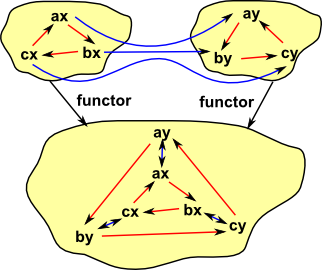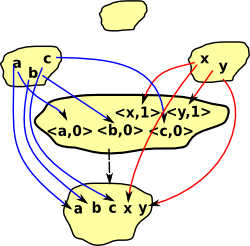 |
A sum in category theory is a kind of colimit. It is dual to a product discussed on the page here. It consists of the sum A+B with two arrows into it, one from A and the other from B. It must have a universal property which is: For any other object Z with maps from A and B there must be a unique arrow from A+B to Z. |
Sum Example in Set
 |
In this diagram the two sets A and B are shown with elements. Some of the elements in A+B have inputs from A, some from B and some from both. So A+B is a (not necessarily disjoint) union. So to comply with the universal property the maps into Z must respect the disjointedness or otherwise of the elements. |
| I have drawn the sum like this: |  |
but when encoding the elements we may need to tag them with a 0 or 1 to know whether they come from A or B. In algebraic terms this is like: A+A = 2*A where 2 means a Boolean type |
(a,0) (b,0) (c,0) (d,0) (c,1) (d,1) (e,1) (f,1) |
Example in Directed Graph
 |
This is like the set example with arrows between the elements. Can we have arrows into and out of the intersection like this? I can't see why not but possibly not when we go on to pushout. |
Table of Results
Sum |
||
|---|---|---|
| generalisation | a kind of colimit | |
| set example |
|
disjoint union {a,b,c}+{x,y}= |
| group | free product the free product for groups is generated by the set of all letters from a similar "almost disjoint" union where no two elements from different sets are allowed to commute. |
|
| Grp (abelian) | direct sum the group generated by the "almost" disjoint union (disjoint union of all nonzero elements, together with a common zero) |
|
| vector space | direct sum | |
| poset | least upper bound join |
|
| base topological space | wedge | |
| POS |
|
least upper bounds (joins) |
| Rng | ||
| Top | disjoint unions with their disjoint union topologies | |
| Grf | ||
| category |
Sum
When generating a sum for objects with structure then the structure associated with the link can be added to the sum object.

Next Steps
see also:


